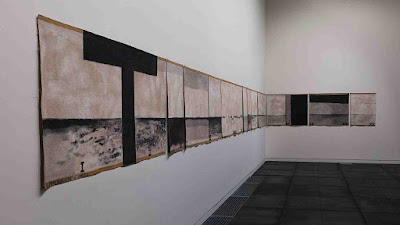If you haven’t yet seen this work, head into the Adam Art
Gallery before this exhibition finishes (this Sunday the 20th!) to
check it out.
 |
| Colin McCahon, Walk (Series C) 1973, synthetic polymer paint on unstretched jute canvas, 11 panels. Collection of Museum of New Zealand Te Papa Tongarewa (photo: Shaun Waugh) |
Walk (Series C), painted in 1973 is a monumental work by Colin McCahon, and seldom seen, since its purchase in recent years from a private collection by Te Papa, who graciously have loaned it to the Adam. Monochromatric, and disarming in size, it is neatly divided into 11 pieces, almost all linked by a single flowing horizon line of the sea. Hung at eye level, it keeps pace with me as I pause on each panel to contemplate. Am I keeping in step with Colin McCahon as he walked alongside this work mindfully, after each panel was complete? Did his eyes drift, slow, and then come to a still to inspect the same minute, scuffings of brush marks, and canvas threads unwinding on the edges? My eyes glide along the morse-code short and long dashes of the horizon line.
We can view this painting as consisting of four layers of journeys or walks, which have been conceptually layered and co-exist.
The first: When we view this work, we, the viewer are compelled to walk from end to end of it in order to examine the whole work. This walk is our own journey of experiencing the painting, and keeps pace with our mental or emotional experience of the work.
The second: In doing so, we fall into step with McCahon’s own physical journey along Muriwai beach – although in different temporal and spatial boundaries – open to the different sensory and emotive experiences of the wind, the sand, the water, the saliferous smell of the sea. After his friend James K. Baxter’s death in 1972, McCahon painted this work as an homage to the poet, perhaps thinking of him as he walked along the beach. Here, he has recorded the seascape, with the water and sky divided by a continuous thin line. McCahon reproduces this experience in his painting, walking alongside the strips of canvas while dabbing and dashing different dividing lines of land, sea, sky. Captured in different possible weather conditions, some are misty, hazy views while some are sharp, and clearly delineated.
| image: www.mccahon.co.nz |
The third: The walk of Christ to his execution, and the
moments leading up to, and following his death. The canvas is marked with the
Roman numerals 1-14, signifying the 14 Christian ‘Stations of the Cross’ – a reflective
journey some people undertake around Easter, following different art works in
physical spaces, or symbolic or literary anchor points in order to contemplate
each experience that Jesus may have gone through. For example, the first panel
has the numerals ‘I’ and ‘II’ inscribed, divided by a thick black ‘T’ of a
cross. These two stations are traditionally held to be Jesus sentenced to death
by crucifixion, and Jesus picking up the cross to carry it up the hill to his
death. Here, the ‘T’ cross marks both the imminent method of execution, and the
physical strain of the beginning of Jesus’ walk, carrying the physical
weight of the instrument of his death. The only other thick black vertical
section McCahon has painted is number 11, Jesus being nailed to the cross. This
heavy, driving downward line brings to mind the exertion of nails being driven
through Christ’s flesh to affix him to the wood. It is followed by three
stacked sections of thicker grey paint, the top section black, for the panel
representing the 12th and 13th stations: Jesus’ death and
deposition from the cross. ‘Reading’ this panel, our eye drags downward on this
canvas from the darkest stripe at the top, effectively mirroring the downward
pulling of Jesus’ body from the cross.
The fourth: The spiritual journey to the afterlife of deceased
Māori souls, up the West coast of Aotearoa New Zealand, past Muriwai beach and
onto the sacred site of Cape Reinga, where they depart from the ancient pohutukawa
tree. There, they travel down the overhanging roots of the tree, into the
ocean. The spirit would surface briefly at Manawatawai (Three Kings Island) to
take a final look at the landscape, occupied by the living, before continuing
on to the next world. McCahon’s end panel, painted white, has a faint tracing
of a line in the sky, floating parallel to the sea – perhaps a spirit taking
its last journey.
No comments:
Post a Comment